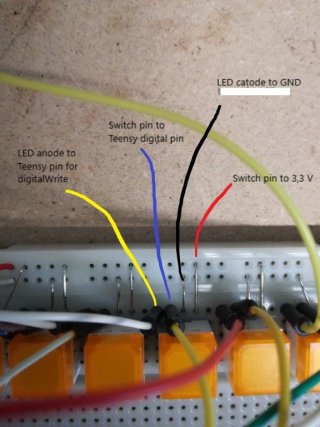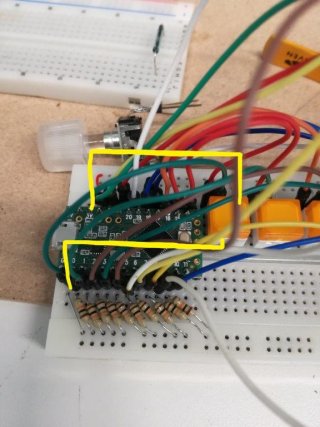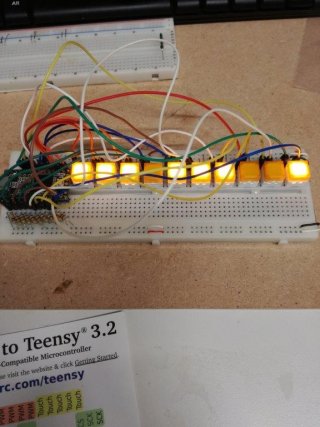GeppettoLab
Active member
Hi!
I'm working on a project in which I have to use 10 led buttons and a Teensy 3.2
I have to recognize when 5 of them (and only that five) are pressed. The right configuration opens an electromagnet (by a relè).
At the same time I have to send a message trough Ethernet when the configuration is right. I will use the WIZ812MJ Module then I must to keep free for now pins 10 to 13.
For the button that I have to use (that are retroilluminated by a led) I use the Interrupt to controll the state of the button and the leds.
Then I must use digital pins from 0 to 9 (for now I don't use the relè, probably I will have to reduce the button to 9 to use the relè too) but the first two, connected to pin 0 and 1 doesn't work.
I controlled all the connection, switching cable and buttons and there is noting wrong in the hardware.
I check the function that i use with the interrupts with a serial print but it doesn't shows noting.
I have also eliminate the Serial initialization thinking about some conflicts , but nothing changes.
Is there a problem with interrupts on this two pins? the same appens in a previous setting using pin 13..
Can you Help me?
I'm working on a project in which I have to use 10 led buttons and a Teensy 3.2
I have to recognize when 5 of them (and only that five) are pressed. The right configuration opens an electromagnet (by a relè).
At the same time I have to send a message trough Ethernet when the configuration is right. I will use the WIZ812MJ Module then I must to keep free for now pins 10 to 13.
For the button that I have to use (that are retroilluminated by a led) I use the Interrupt to controll the state of the button and the leds.
Then I must use digital pins from 0 to 9 (for now I don't use the relè, probably I will have to reduce the button to 9 to use the relè too) but the first two, connected to pin 0 and 1 doesn't work.
I controlled all the connection, switching cable and buttons and there is noting wrong in the hardware.
I check the function that i use with the interrupts with a serial print but it doesn't shows noting.
I have also eliminate the Serial initialization thinking about some conflicts , but nothing changes.
Is there a problem with interrupts on this two pins? the same appens in a previous setting using pin 13..
Can you Help me?
Code:
// TEENSY 3.2
const int LEVEL = 10;
int sequence[LEVEL] = {0, 1, 1, 0, 0, 0 ,1, 1, 1, 0}; //the right sequence
int yourSequence[LEVEL] = {0, 0, 0, 0, 0, 0, 0, 0, 0, 0}; //user sequence
int relayPin = 6;
boolean light_01 = 0;
boolean light_02 = 0;
boolean light_03 = 0;
boolean light_04 = 0;
boolean light_05 = 0;
boolean light_06 = 0;
boolean light_07 = 0;
boolean light_08 = 0;
boolean light_09 = 0;
boolean light_10 = 0;
int switchPin_01 = 0;
int switchPin_02 = 1;
int switchPin_03 = 2;
int switchPin_04 = 3;
int switchPin_05 = 4;
int switchPin_06 = 5;
int switchPin_07 = 6;
int switchPin_08 = 7;
int switchPin_09 = 8;
int switchPin_10 = 9;
int lightPin_01 = 14 ;
int lightPin_02 = 15;
int lightPin_03 = 16;
int lightPin_04 = 17;
int lightPin_05 = 18;
int lightPin_06 = 19;
int lightPin_07 = 20;
int lightPin_08 = 21;
int lightPin_09 = 22;
int lightPin_10 = 23;
void setup() {
Serial.begin(9600);
pinMode(lightPin_01, OUTPUT);
pinMode(lightPin_02, OUTPUT);
pinMode(lightPin_03, OUTPUT);
pinMode(lightPin_04, OUTPUT);
pinMode(lightPin_05, OUTPUT);
pinMode(lightPin_06, OUTPUT);
pinMode(lightPin_07, OUTPUT);
pinMode(lightPin_08, OUTPUT);
pinMode(lightPin_09, OUTPUT);
pinMode(lightPin_10, OUTPUT);
pinMode(switchPin_01, INPUT);
pinMode(switchPin_02, INPUT);
pinMode(switchPin_03, INPUT);
pinMode(switchPin_04, INPUT);
pinMode(switchPin_05, INPUT);
pinMode(switchPin_06, INPUT);
pinMode(switchPin_07, INPUT);
pinMode(switchPin_08, INPUT);
pinMode(switchPin_09, INPUT);
pinMode(switchPin_10, INPUT);
// pinMode(relayPin, OUTPUT);
//
// digitalWrite(relayPin, LOW);
digitalWrite(lightPin_01, LOW);
digitalWrite(lightPin_02, LOW);
digitalWrite(lightPin_03, LOW);
digitalWrite(lightPin_04, LOW);
digitalWrite(lightPin_05, LOW);
digitalWrite(lightPin_06, LOW);
digitalWrite(lightPin_07, LOW);
digitalWrite(lightPin_08, LOW);
digitalWrite(lightPin_09, LOW);
digitalWrite(lightPin_10, LOW);
attachInterrupt(switchPin_01, lightOn01, FALLING);
attachInterrupt(switchPin_02, lightOn02, FALLING);
attachInterrupt(switchPin_03, lightOn03, FALLING);
attachInterrupt(switchPin_04, lightOn04, FALLING);
attachInterrupt(switchPin_05, lightOn05, FALLING);
attachInterrupt(switchPin_06, lightOn06, FALLING);
attachInterrupt(switchPin_07, lightOn07, FALLING);
attachInterrupt(switchPin_08, lightOn08, FALLING);
attachInterrupt(switchPin_09, lightOn09, FALLING);
attachInterrupt(switchPin_10, lightOn10, FALLING);
}
void loop()
{
if (seq_cmp(yourSequence, sequence)) Serial.println("OK"); //compare the two sequences
}
void lightOn01() { //if the button is pressed change the state of the LED and change the value in the yourSequence array
Serial.println("1 pressed");
static unsigned long last_interrupt_time = 0;
unsigned long interrupt_time = millis();
if (interrupt_time - last_interrupt_time > 200)
{
if (light_01 == LOW) light_01 = HIGH;
else light_01 = LOW;
yourSequence[0] = light_01;
digitalWrite(lightPin_01, light_01);
}
last_interrupt_time = interrupt_time;
}
void lightOn02() {
Serial.println("2 pressed");
static unsigned long last_interrupt_time = 0;
unsigned long interrupt_time = millis();
if (interrupt_time - last_interrupt_time > 200)
{
if (light_02 == LOW) light_02 = HIGH;
else light_02 = LOW;
yourSequence[1] = light_02;
digitalWrite(lightPin_02, light_02);
}
last_interrupt_time = interrupt_time;
}
void lightOn03() {
static unsigned long last_interrupt_time = 0;
unsigned long interrupt_time = millis();
if (interrupt_time - last_interrupt_time > 200)
{
if (light_03 == LOW) light_03 = HIGH;
else light_03 = LOW;
yourSequence[2] = light_03;
digitalWrite(lightPin_03, light_03);
}
last_interrupt_time = interrupt_time;
}
void lightOn04() {
static unsigned long last_interrupt_time = 0;
unsigned long interrupt_time = millis();
if (interrupt_time - last_interrupt_time > 200)
{
if (light_04 == LOW) light_04 = HIGH;
else light_04 = LOW;
yourSequence[3] = light_04;
digitalWrite(lightPin_04, light_04);
}
last_interrupt_time = interrupt_time;
}
void lightOn05() {
static unsigned long last_interrupt_time = 0;
unsigned long interrupt_time = millis();
if (interrupt_time - last_interrupt_time > 200)
{
if (light_05 == LOW) light_05 = HIGH;
else light_05 = LOW;
yourSequence[4] = light_05;
digitalWrite(lightPin_05, light_05);
}
last_interrupt_time = interrupt_time;
}
void lightOn06() {
static unsigned long last_interrupt_time = 0;
unsigned long interrupt_time = millis();
if (interrupt_time - last_interrupt_time > 200)
{
if (light_06 == LOW) light_06 = HIGH;
else light_06 = LOW;
yourSequence[5] = light_06;
digitalWrite(lightPin_06, light_06);
}
last_interrupt_time = interrupt_time;
}
void lightOn07() {
static unsigned long last_interrupt_time = 0;
unsigned long interrupt_time = millis();
if (interrupt_time - last_interrupt_time > 200)
{
if (light_07 == LOW) light_07 = HIGH;
else light_07 = LOW;
yourSequence[6] = light_07;
digitalWrite(lightPin_07, light_07);
}
last_interrupt_time = interrupt_time;
}
void lightOn08() {
static unsigned long last_interrupt_time = 0;
unsigned long interrupt_time = millis();
if (interrupt_time - last_interrupt_time > 200)
{
if (light_08 == LOW) light_08 = HIGH;
else light_08 = LOW;
yourSequence[7] = light_08;
digitalWrite(lightPin_08, light_08);
}
last_interrupt_time = interrupt_time;
}
void lightOn09() {
static unsigned long last_interrupt_time = 0;
unsigned long interrupt_time = millis();
if (interrupt_time - last_interrupt_time > 200)
{
if (light_09 == LOW) light_09 = HIGH;
else light_09 = LOW;
yourSequence[8] = light_09;
digitalWrite(lightPin_09, light_09);
}
last_interrupt_time = interrupt_time;
}
void lightOn10() {
static unsigned long last_interrupt_time = 0;
unsigned long interrupt_time = millis();
if (interrupt_time - last_interrupt_time > 200)
{
if (light_10 == LOW) light_10 = HIGH;
else light_10 = LOW;
yourSequence[9] = light_10;
digitalWrite(lightPin_10, light_10);
}
last_interrupt_time = interrupt_time;
}
//compare the two sequences
boolean seq_cmp(int *a, int *b) {
for (int n = 0; n < LEVEL; n++) if (a[n] != b[n]) return false;
return true;
}



